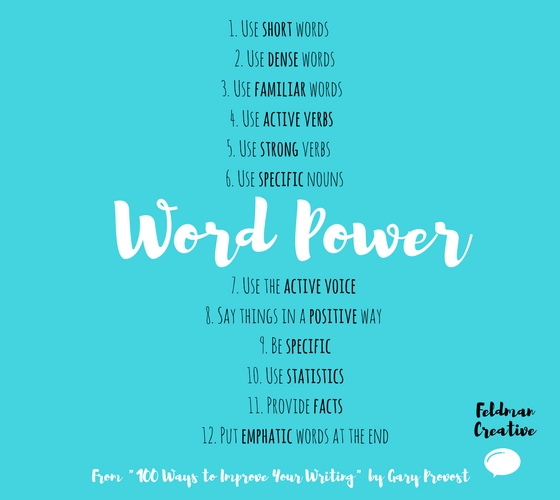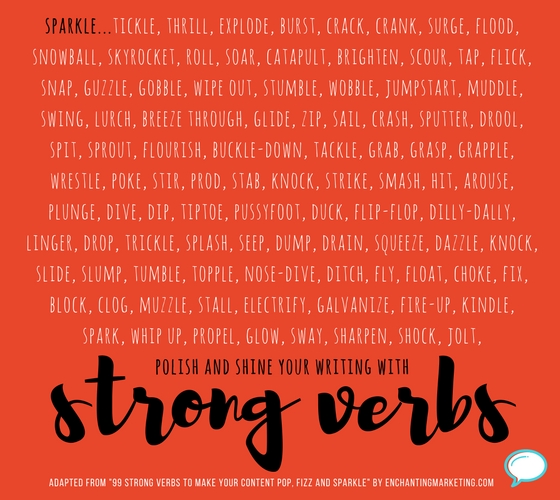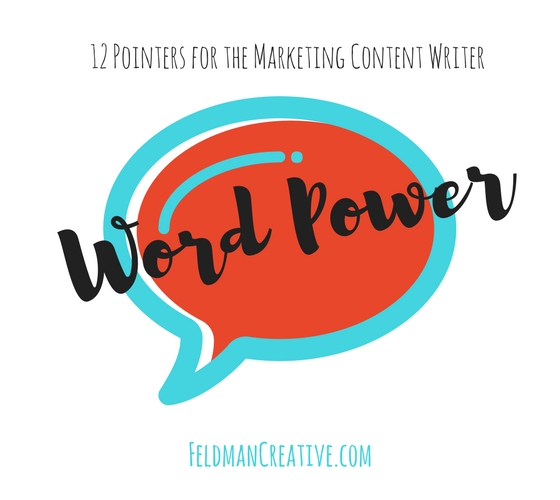If it’s “word power” you’re hoping to achieve, 100 Ways to Improve Your Writing, by the late Gary Provost, is the ultimate manual. It’s the best writing guide I’ve ever read.
If you read my stuff, you know the subject is near and dear to me. If I can give you pointers to improve your writing, you know I will. It’s my job to improve your word power. I can do if for you, with you, or consult you on it.
Provost’s book, published in 1985, includes a chapter titled. “12 Ways to Give your Words Power.” Who doesn’t want that? Here they are:
- Use short words
- Use dense words
- Use familiar words
- Use active verbs
- Use strong verbs
- Use specific nouns
- Use the active voice
- Say things in a positive way
- Be specific
- Use statistics
- Provide facts
- Put emphatic words at the end

Juicy stuff. Of course, Gary wasn’t writing to bloggers or marketing content writers. In his day, such a thing didn’t exist. At least the vernacular of the day couldn’t allow him to use such words.
But writing is writing. Its lessons are timeless. Though the media changes the game (and sometimes the name of the game), effective writing tactics have no expiration date.
In this post, I’ll share his lessons, but give them context for the marketing content writer of today. If you write marketing content, you’ve come to the right page.
Use short words
Extra syllables don’t make your copy work harder; they make the reader work harder.
So don’t try too hard to protract your prose with sumptuous words. Short words deliver greater word power. If it’s punch you want, use the word “punch.”
- Grandiose vs. grand
- Discontinue vs. stop
- Assassination vs. murder
- Congregation vs. crowd
- Pontificate vs. think
In each case above, the shorter word works harder. Check out this tidbit from one of my favorite marketing content writers, Doug Kessler:
Bad writers sit up straight when they write. This is so they can bear the weight of their writing hat.
Good writers recline and slouch and cross their legs and make those snow angels. Because they don’t own a writing hat. They just speak, using a keyboard.
Yes, Doug has a great vocabulary. But he nails it here with one and two-syllable words.
Use dense words
Circumlocution (the use of many words where fewer will do) sucks.
Less is more is the lesson here. You’re not only looking to use short words, but fewer words. Gary explains dense words cram a lot of meaning into a small space.
- People they didn’t know vs. strangers
- Impossible to imagine vs. inconceivable
- Once in a great while vs. rarely
Gary’s “Word Power” doesn’t make the point to remove throwaway phrases, but while we’re talking about reducing bloat, I will. “Needless to say” is needless to say. It’s writer speak for “uh, uh, uh.”
Review your content for stuff like…
- Can I ask you a question?
- In today’s world…
- As you live your life…
In today’s short attention span world, adding useless words to the things you write is unnecessary because it really makes your writing that much harder for your readers to understand your point.
OMG! That last sentence was some seriously crappy writing. Let me fix it for you…
In today’s short attention span world, adding useless words to the things that you write is unnecessary because it really makes your writing that much harder for your readers to understand your point.
There we go:
Useless words make your writing harder to understand.
Use familiar words
You want readers to use their imagination, not their dictionaries. So beware: unfamiliar words are trouble.

Marketing writers sometimes wrestle with “jargon,” words and phrases associated with a specific profession or trade. Jargon can be useful. For instance, medical professionals writing to each other might say:
“CBC, BMP, and LFTs levels were negative.” Using the abbreviations actually helps get to the point in this context.
However, the patient who didn’t study medicine would prefer to read something like:
“Your blood, kidney and liver tests came out normal.”
Watch out. Every area has its own jargon. In a blog post like this, I could share ideas about ad hominem, allegory and assonance, but if I’m concerned about confusing you, I could simply explain a few literary devices, er, writing tricks.
Use active verbs
A verb can be active or passive. When the verb is passive, the subject undergoes the action rather than doing it. Example:
Spanish is spoken by more than 300 million people worldwide.
A version of this sentence using an active verb (where the subject does the action) would be:
More than 300 million people worldwide speak Spanish.
Gary explains you gain power in your writing by using active verbs. Note I didn’t paraphrase Gary by writing:
Your writing gains power when active verbs are used.
Try to find opportunities to replace words such as is, are, was, and will be with active verbs.
Use strong verbs
Verbs energize your work. Strong verbs dial-up the energy even more. Strengthen your verbs by making them precise. By doing so, you’ll often be able to avoid adverbs, which are often tacked onto weaker verbs.
- Walk nervously vs. pace
- Eat hungrily vs. devour
- Pushed forcefully vs. slammed
I love this pointer. I think it’s a tactic that (1) pumps-up your content and (2) is easy to do to every first draft.

Source: 99 Strong Verbs to Make Your Content Pop, Fizz and Sparkle, by Enchanting Marketing
Think of this tip when reviewing your headlines. Can you make it stronger by replacing a so-so verb with a strong one? Here an example, with a headline I found and version I wrote as alternative:
- Before: How to Better Serve Customers With Twitter Direct Messages
- After: How to Delight Customers With Twitter Direct Messages
Use specific nouns
Use specific nouns to make your content more meaningful. Specific nouns deliver more information. More information = more interesting.
- They surprised the kids with a puppy.
- They surprised the kids with a eight-week old labradoodle.
- A man grabbed the microphone.
- A protester grabbed the microphone.
- Music blared from the speakers.
- Pink Floyd blared from the speakers.
I hope you agree, in each case, the second sentence featuring the specific noun, sparks more interest.
Gary says to look for adjectives doing the work a better noun could do instead. Did they live in a “very large house” or a mansion?
Use the active voice
In most instances, your writing compels the reader better when you use the active voice.
Let me restate what I just wrote in a passive voice:
When you use the active voice, in most instances, the reader is more compelled by your writing.
I’ll demonstrate again, starting with the passive voice this time:
The blog post about word power was approved by the editor.
It’s clear, but dull. I present a simple alternative with an active voice:
The editor approved the blog post about word power.
Say things in a positive way
I don’t want you to misunderstand this one. The tip isn’t about avoiding negative things. I’m a big advocate of writing contrarian points of view and pointing out problems.
Writing things in a positive way means pointing out what did happen, what does exist, and who was involved—instead of what didn’t, doesn’t and wasn’t.
Here an example of what I mean:
- The manuscript sucked.
- The manuscript wasn’t great.
The first line isn’t a positive thought. But it makes its case positively. The weaker line that follows makes the same point negatively. Again…
- They served us ice-cold soup.
- They served us soup that wasn’t hot.
Be specific
Here’s an interesting challenge for you: be specific without being wordy. With specifics, you paint better pictures and tell more engaging stories. You’ll need to draw the line by making judgment calls.
You could be unspecific:
The company makes software.
You could be specific:
The company makes cloud-based software to help social media managers save time.
But you could be tediously specific and run the risk of boring or confusing readers:
The company makes affordable, easy-to-learn, cloud-based software to help community managers save time by automatically scheduling social media posts across various channels in advance and pro-actively assessing the reach and resonance of their content.
Laughing? I see that shit everyday.
Use statistics
Establish greater credibility with statistics. Demonstrate you’ve done your homework and understand what matters.
I recently wrote this in an eBook for a client:
A recent survey of investors by the Financial Planning Association and LinkedIn found that over half of respondents between 18 and 44 perform an online search for an advisor before making contact with them.
In the copy that follows, when I proceed to hammer home the importance of SEO in the financial advisor business, I have credibility working for me.
Provide facts
Often, you can make your point more powerfully by presenting facts. In the following paragraph I’m going to make a case. It’s truthful, but no facts are presented.
A small percentage of content marketing teams have six or more people. Most are smaller. In either case, companies struggle to find the right talent.
Now look at the same information, this time, featuring a series of research-based facts.
According to research conducted by Kapost, fewer than 20% of content marketing teams comprise six or more people. Almost half of the respondents in their survey had teams of 2-5. The same research reports 83.7% of companies find hiring for content marketing talent difficult.
In the first example, you have to take my word for it. In the second, the facts add a healthy dose of credibility.
Put emphatic words at the end
The impact of your sentence is bound to come from the words you place at the end. I’ll demonstrate by concluding this post with the same idea in two different ways.
You can become a more effective marketing content writer by increasing your word power.
Increasing your word power is the key to becoming a more effective marketing content writer.



![Business Blogging Trends – 4th Annual Survey [Content Jam Episode 36] Business Blogging Trends – 4th Annual Survey [Content Jam Episode 36]](https://feldmancreative.com/wp-content/uploads/2018/10/Content-Jam-podcast-36.jpg)


![The Secrets of Succesful Bloggers [Content Matters Episode 24] + INFOGRAPHIC The Secrets of Succesful Bloggers [Content Matters Episode 24] + INFOGRAPHIC](https://feldmancreative.com/wp-content/uploads/2017/03/Episode-24.jpg)
Comments
Emmerey Rose
Amazing tips Barry. This definitely helps a lot in writing content.
Cindy Fox
Thank you Barry. Very helpful. Creating an interest challenge without being wordy is where it’s at for me.
Denise Beecroft
Gold.
Barry Feldman
I wish there were a like/love/thumbs up button for Disqus. Thanks, Goldie.